
AP

You might remember Marilyn Tavenner, the former head of the Centers for Medicare and Medicaid Services who also oversaw the disastrous Obamacare rollout.
Tavenner is now president and CEO of America’s Health Insurance Plans, and she just gave an interview to Morning Consult about 2017 Obamacare premiums — and said the news isn't good.
 Then-Medicare chief Marilyn Tavenner testifies before the Senate Health, Education, Labor and Pensions Committee Nov. 5, 2013. (AP Photo/J. Scott Applewhite)
Then-Medicare chief Marilyn Tavenner testifies before the Senate Health, Education, Labor and Pensions Committee Nov. 5, 2013. (AP Photo/J. Scott Applewhite)
“I’ve been asked, what are the premiums going to look like?" Tanvenner told Morning Consult. "I don’t know, because it also varies by state, market, even within markets. But I think the overall trend is going to be higher than we saw previous years. That’s my big prediction."
The Obama administration, as you might expect, is trying to quell those fears.
“A new report by the Department of Health and Human Services debunks the myth, based on last year’s rate filings, that average consumers experienced double-digit percentage premium increases for coverage on the health insurance marketplace in 2016,” Ben Wakana, an HHS spokesman, told Morning Consult.
He added to the outlet that changes in health rates “are not a reliable indicator of what typical consumers will actually pay” and that tax credits generally reduce coverage costs while consumers have “a chance to find the best deal" by shopping for the best rates.
Morning Consult indicated that rates for the average consumer — when subsidies and rate shopping were factored in — increased about 4 percent this year.
Tavenner, however, told the outlet that a handful of factors indicate 2017 rates will run higher. Besides rising medical and drug costs, she said regulations built into Obamacare don't help.
More from Morning Consult:
Finally, there are the market shifts that come from Obamacare. The law created a robust set of regulations for insurance plans. Insurers’ profits are capped, there is a set of benefits they are mandated to cover, and they can’t deny health coverage based on pre-existing conditions. There are also tight requirements surrounding benefit design. All those rules cost money. The idea was that this costly restructuring of the insurance market would be offset by an influx of healthy customers, so that insurers would be kept in business. That hasn’t happened as people hoped it would.The insurance exchanges established under the Affordable Care Act come with their own set of new challenges. “It’s kind of like a myriad of factors. It’s not one factor,” Tavenner said.
Exchanges are different than other insurance markets. They tend to have sicker enrollees, made up of the people who were denied coverage before Obamacare or who didn’t get insurance through their employers.
In addition, Tavenner told the outlet that Affordable Care Act marketplaces remain unstable — indeed more than half of the nonprofit co-op insurers established under the ACA have failed, Morning Consult added. United Health, America's biggest insurer, said this week it's drastically cutting back on exchanges.
Low federal funding for risk corridors — which covers higher-than-expected claims — also likely will factor into higher 2017 premiums.
“Remember both risk corridor — i.e. there’s no cash there, that we’re aware of. So there won’t be any predictability after last year that there’ll be cash this year. Reinsurance is going away, this is the last year of the reinsurance,” Tavenner told Morning Consult. “So they’re going to have to price over, around, or at least take into account what’s going on with risk corridors and reinsurance. So that’s a trend in the wrong direction.”
And finally, Tavenner told the outlet that since Obamacare enrollees are shopping around, insurers can't easily foresee what their rosters will look like next year.
“The problem with the exchanges, based on the data that plans have provided, and even some of the data that CMS has, is people are still kind of seeing this as ‘I use insurance when I’m sick, but I may not need it when I’m no longer sick,’” she told Morning Consult. “So they tend to churn. And that churn increases premiums. So you have to kind of price over that.”
(H/T: The Fiscal Times)